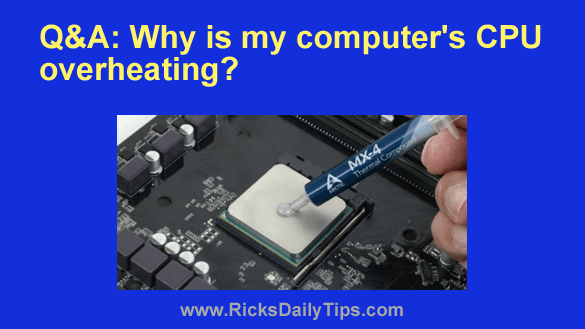 Note: The links in this post are affiliate links.
Note: The links in this post are affiliate links.
Question from Darryl: Several years ago I paid a friend of mine to build me a desktop computer.
This machine has an Intel CPU and 8GB of RAM. There is no video card because it’s using the integrated video on the motherboard.
This machine has worked perfectly for years but now it’s started overheating and shutting down on me. The CPU temperature reached 170 degrees before it shut down last time.
What could be causing this?
I disassembled the computer (including removing the motherboard and power supply) and blew the dust out of it, then put it all back together. But the problem is still there.
In case you’re wondering, I’ve checked the speed of the fans multiple times and there’s no problem there.
What could be causing the CPU to overheat and shut the system down?
Rick’s answer: Darryl, there are several possible reasons why your PC could be overheating and shutting down on you, and you have already eliminated two of the most likely culprits (dust and fan issues).
I recommend that you try the following and see if they help:
1 – Purchase a tube of thermal compound paste and apply it to the CPU. Thermal paste breaks down over time and loses its ability to effective transfer heat, and that could well be what happened here.
By the way, regardless of what you might read elsewhere, you don’t have to pay a small fortune for quality thermal paste. In fact, the one I use currently costs just a few bucks on Amazon.
When you go to apply the new thermal paste, be sure to thoroughly remove the old paste from both the heat sink and the CPU before applying the new paste.
Also, you don’t need to slather the new paste onto the CPU. What you’re shooting for is a paper-thin layer that covers the entire surface of the CPU.
The best way to apply the paste is to squeeze a small dot of it onto the center of the CPU and spread it around evenly. If you find that you need a little more you can add it.
2 – After you have replaced the old thermal paste with a layer of new paste power the machine up and run the malware scans I recommend in this post.
Viruses and other forms of malware can easily over-work a CPU and bring the system to its knees. That’s why I always recommend a thorough malware screening any time a Windows PC is overheating.
That’s all there is to it, Darryl. I feel fairly certain that the two steps detailed above will fix your computer’s overheating problem. If not, let me know and I’ll tell you what to try next.
Update from Darryl: It was the paste. When I removed the CPU cooler I found that it had dried out and cracked. I replaced it with new paste and now everything is working great. Thanks for your help.